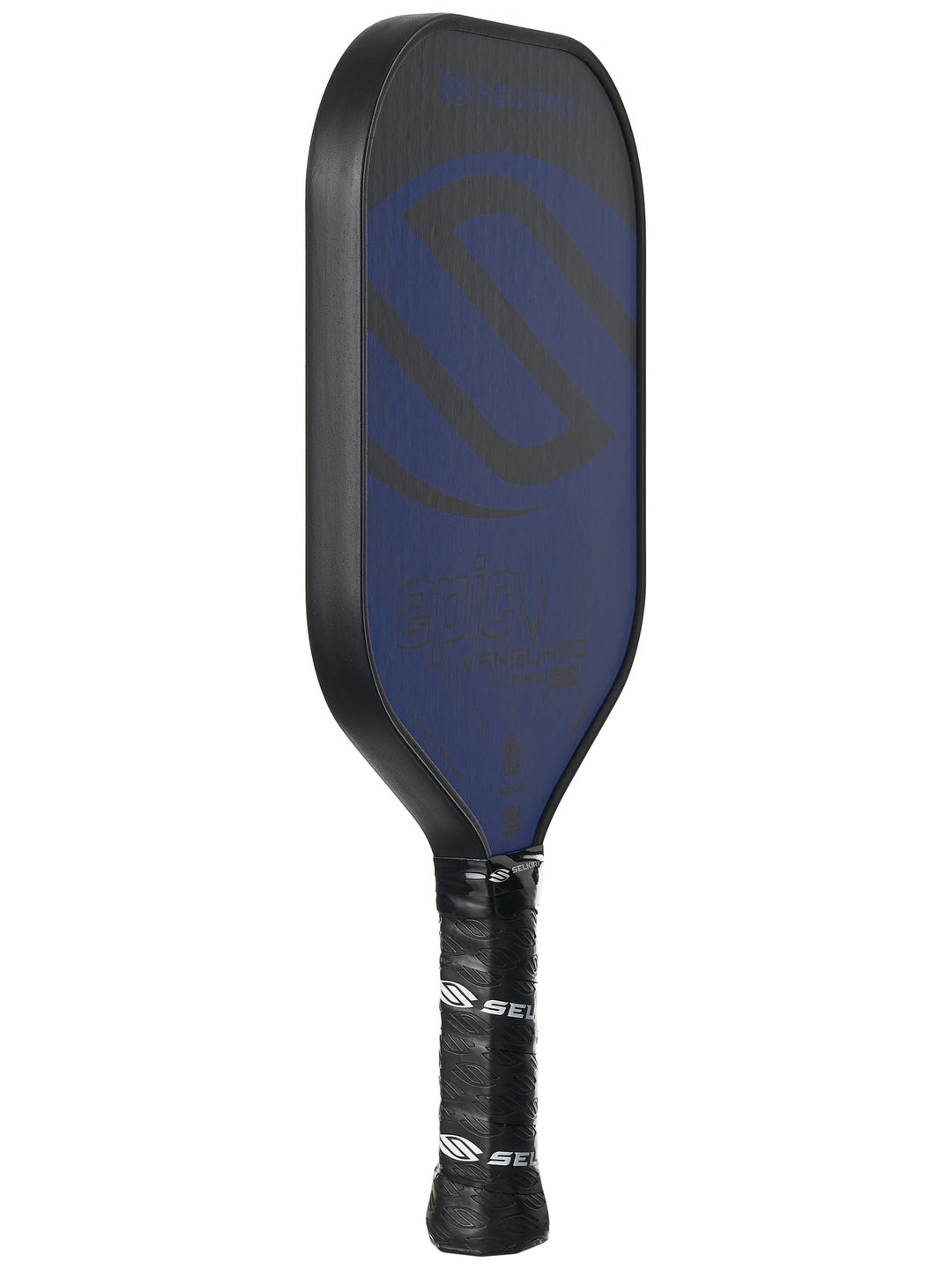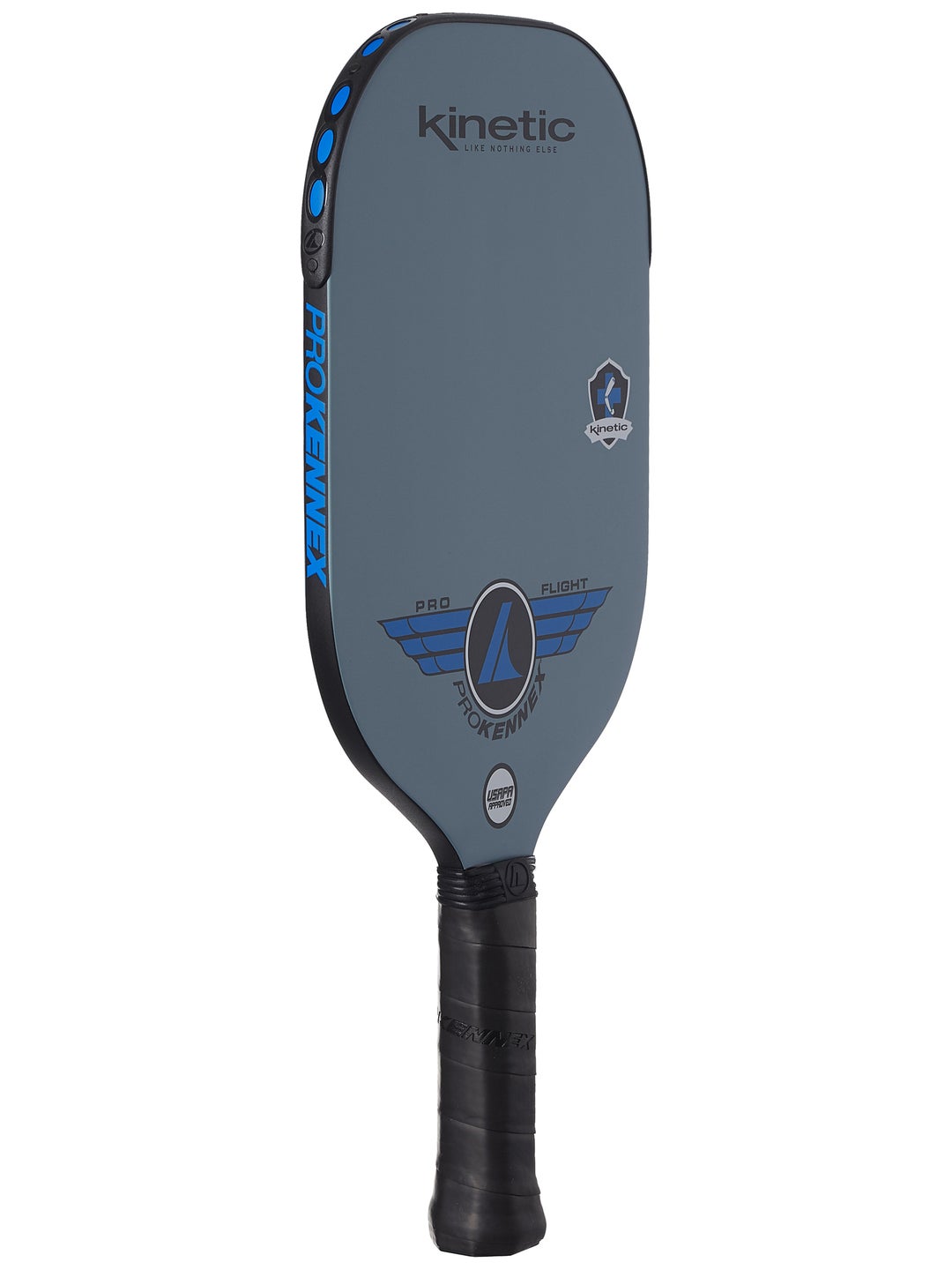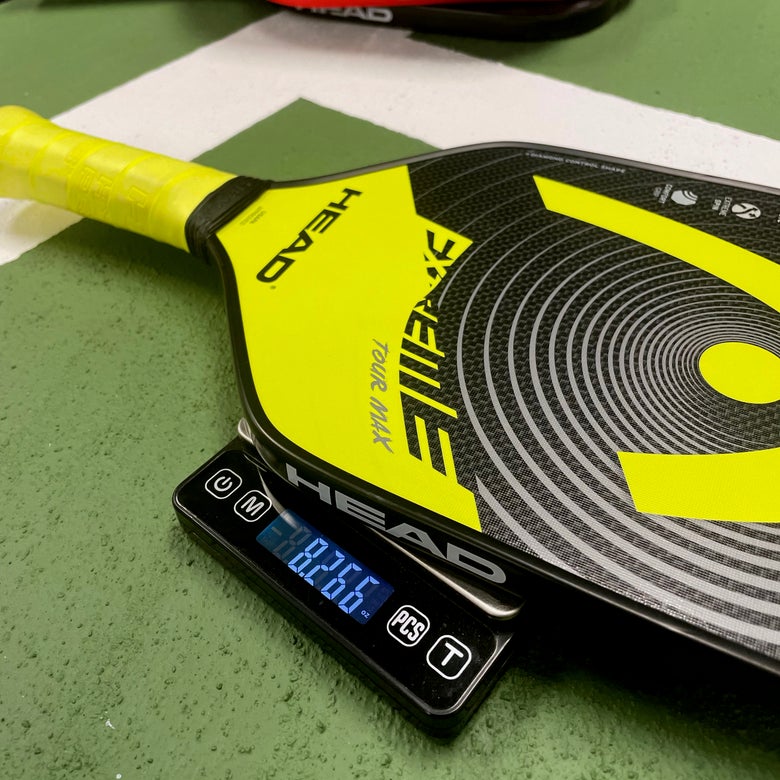How to Choose a Pickleball Paddle
If you are new to the sport of pickleball and are considering your first purchase of a paddle or are maybe upgrading from that first paddle, you have probably noticed a huge increase in the number of different options to choose from. As a result finding one that best suits your game and budget can seem daunting. To help minimize the time it can take to pick the right paddle we will offer some valuable information on paddle characteristics and how they affect performance. (Updated November 2024)
Getting Started
To help whittle down the vast selection of pickleball paddles currently on the market, to the one(s) that will best complement your game, let's discuss the various traits that determine performance. The aspects of a paddle that most noticeably affect playability are:
- weight
- construction
- shape
- core material
- core thickness
- surface materials
To a slightly lesser degree, the following traits also contribute to the performance of a paddle:
- grip diameter
- handle length
See Our Favorite Pickleball Paddles: Best Pickleball Paddles
Basic Paddle Terms and Definitions Explained
| Paddle Term | Definition |
| Weight | Overall mass or static weight of paddle. |
| Construction | Technique/method of paddle assembly. |
| Shape | 3 shapes within the 24 inch overall dimension rule: Compact, elongated and hybrid. |
| Core Material | The composition of the paddle core that's encased between both sides of the paddle surface. |
| Core Thickness | The thickness of the core, usually denoted in millimeters. |
| Surface Material | The two sides of the paddle face that make contact with the ball. |
| Grip Size | The measured the distance around outside of grip. |
| Handle Length | The measurement of the handle, from butt cap to the throat of a paddle. |
Paddle Weight
Weight is probably the first and one of the most noticeable aspects of a pickleball paddle. Beginning from the moment you pick it up through the moment until you put the paddle down, you cannot help but notice whether the paddle feels heavy, light or just right. Paddle weight affects everything from power, stability and control to comfort and maneuverability. Paddles are typically categorized into three weight categories: Lightweight, midweight or heavyweight.
Lightweight Paddles: 7.4 ounces or less
There are more than a few advantages to choosing a paddle that weighs less than 7.5 ounces. Here are some of the positives lighter paddles provide:
- Reaction time and maneuverability - Paddles weighing less than 7.5 ounces will be easy to get into position shot after shot and play with hour after hour.
- Short and soft game - Lighter paddles complement finesse shots and the short game in near the kitchen.
- Turnkey fun and performance - Lighter options are great for extremely young or older players since ball pace and spin is usually not excessive.
Some potential drawbacks of using lighter paddles:
- Vibration Control - This ties into paddle comfort. Lighter paddles are easier to swing, which does relate to comfort in between shots. However, light paddles use less material, which means fewer vibrations are being filtered out at contact of the ball.
- Lack of stability - If ball pace and spin becomes excessive and/or ball contact is off center, lighter paddles can feel unstable. Even if your paddle wobbles just a little, the shot result is most often entirely off. This can actually lead to discomfort or an overuse injury. Once the player senses the instability the remedy usually involves a tighter squeeze on the handle. This may cure the stability issue, but squeezing the grip to hard restricts your range of swing motion and thus the quality of your shots.
- Shot depth - Hitting shots from baseline to baseline or producing enough power to pass opponents at the NVZ can be a chore.
Midweight Paddles: 7.5 - 8.2 ounces
There is no unanimous or official agreement as to exactly where light paddles end and midweight paddles begin, but we feel that a paddle weighing between 7.5 – 8.2 ounces represents middle ground. One of the main attractions of paddles in this weight range is the balance they strike between all-out power and control. Besides that huge benefit, there are a few more worth mentioning:
- All-court capability – Players who want to develop their transitional game, from the baseline to the midcourt and kitchen, seem to gain the most and lose the least in this range of paddle weight.
- Stability – Midweight paddles are less prone to wobble at contact of the ball, especially during off-center contact and in windy conditions. Minimizing how much your paddle wobbles throughout the contact portion of your swing equates to more of your shots making it to their intended destination.
- Generating power – Power on shots from the baseline, like groundstrokes, serves and service returns, is easier to create when compared to swinging a lighter paddle from the backcourt.
- Absorbing pace - This also ties into the stability of a paddle. When trying to dial back the pace of play by taking the sting out of an opponent’s heavy shot making, midweight paddles achieve this with minimal fuss (instability).
- Directional control – The safest (low risk) shot is to hit the ball back in the direction it came from, but that typically comes with a low reward result. Hitting the ball straight off of angles, or hitting angles off of straight-flying shots often produces a far higher reward. With a midweight paddle in hand the reward comes at a far lower risk.
- Comfort – Paddles in the mid-range of weight do a better job at filtering vibration created at ball contact. And at least up to 8 ounces, for most individuals, midweight paddles are light enough to be comfortable for all-day play.
Potential Drawbacks - This is the range of paddle weight that probably benefits the largest group of players. If there is a drawback one could point to how much difference there is between a paddle that weighs 7.5 ounces and another that weighs close to 8.3 ounces. Two paddles that are the same in every way with the exception of one weighing 7.5 and the other weighing 8.3 ounces are entirely different paddles.
Heavyweight Paddles: 8.3 ounces and over
With the exception of maneuverability paddles weighing more than 8.3 ounces simply offer a higher degree of everything that lighter paddles provide. A paddle weight north of 8.3 ounces typically afford lots of:
- Stability – Heavier paddles are less apt to slow down, veer off path or wobble in windy conditions or under the pressure of heavy shot pace. They just plow through whatever is in their way.
- Power – The power generated by heavier paddles comes mostly in the form of momentum. In effect, you get more weight from the paddle behind the ball, plus the paddle does not flutter as much at contact of the ball.
- Comfort – More material means your paddle will be heavier and will also do a better job at dispersing or minimizing vibration created at contact of the ball.
If exceedingly heavy, drawbacks may involve:
- Maneuverability - Shot timing can be a chore near the kitchen where reaction time is minimal. Lack of paddle agility may not be apparent for the first couple of shots, but it can become an issue by the time you get to the third and fourth shot of a fast-paced rally or you are playing for an extended period of time.
- Discomfort or even potential for injury - Ideally, you should be able maintain your balance and position while swinging a paddle. If you are thrown off balance at the end of your swing, the paddle is too heavy. Continued use of a paddle that is too heavy can also create some discomfort or worse. Overall there is probably more risk of arm discomfort from using too light of a paddle, rather than a heavy one, due to excessive vibration and instability.
Paddle Construction
After wood paddles came the first composite paddles which are made from a variety of materials. And the first generation of those paddles were constructed (assembled) using epoxy glues and cold-pressing each layer or piece together to form a single paddle.
Second generation paddle construction is sometimes referred to as:
- thermo-formed
- uni-body
- uni-frame
- single-piece
This method of construction takes the same basic materials, puts them together and places them in a mold. The materials are then either heated up and/or compressed together for specific time which produces a single-piece paddle frame.
1st generation construction is still relevant and very popular today. Power wise, 2nd generation paddles will be a bit livelier. Not to the point where you can compare 1st and 2nd Gen. construction to wood and aluminum baseball bats (respectively), but there is a difference in the amount of energy returned to the ball.
Paddle Shape
The shape of your paddle is another noticeable aspect of paddle performance. Currently there are two basic shapes (square and rectangular) with a third (hybrid) being a blend of the two standard shapes. Paddles longer than 16 inches offer more reach and power on the swing. Shorter paddles (16 inches or shorter) feel more maneuverable to swing. Many players also indicate that compact paddle shapes also provide a more connected feel to the ball.
Options longer than 16 inches tend to be narrower across the face, which makes the paddle easier for players to roll their shots with topspin. Shorter paddles most often exhibit a slightly wider span across paddle face, which improves stability and the size of the sweetspot while maintaining a high degree of maneuverability. Hybrid designs can be a little over or under 16 inches in length and may feature either more of a square or rectangular paddle face. The common trait tends to be a handle length of 5.25 inches or more.
Core Materials
Polypropylene (polymer)
Currently, polymer polypropylene honeycomb is the most common material used for the core of a pickleball paddle. Polymer provides a plusher feel compared to Nomex and is versatile enough to complement both driving power along with great touch around the kitchen. Thicker polypropylene cores enhance control while a thinner core profile delivers more power. Besides offering all-around playability, polymer cores are also quieter than aluminum and Nomex cores. If you aren't sure which to choose, we recommend picking a paddle with a polymer core for its versatility.
Nomex
Although less common these days, Nomex honeycomb cores are not entirely retired from use. However, due to the higher decibel level this material produces at contact of the ball, Nomex is not as popular compared to a polypropylene core. Nomex cores are firmer and easily produce the most power but can come at the expense of some valuable control.
Aluminum
Aluminum cores are lighter weight and lower powered compared to polypropylene or Nomex cores. These cores are not as noisy as Nomex, but aluminum still produces more sound than a polymer core. Many junior paddles are still made with an aluminum core because it is easier to keep paddle weight to a minimum with this material.
Core Thickness


The thickness of your paddle's core is definitely worth consideration. Core thicknesses also contributes to the Big 3: power, control and comfort. Paddle core profiles typically range from 10 to 20 mm. Knowing how core thickness affects performance is important because many paddles are offered in more than one core thickness.
Thicker Cores - If we are comparing the same core material (polypropylene), but in different thicknesses, the thicker core will be lower powered (more control) compared to the same paddle with a thinner core. A thicker core also does a better job at dispersing vibration, which increases overall paddle comfort. Cores that 15 mm and greater are considered to be on the thicker side. If unsure, we recommend going with a core thickness between 14 mm and 16 mm.
Thinner Cores - In general, thinner polypropylene cores are livelier than thicker cores of the same material. A core measures less than 14 mm thick returns a lot of shot energy (power) back to the ball instead of being absorbed at impact. This equates to easier shot depth with less effort required to generate it. However, depending on the paddle's weight, thinner paddles typically produce more sound, can feel firm and as though the sweetspot is less forgiving. Although paddle power is derived from several aspects, when players consider a paddle to have good "pop" that most often refers to a lively core.
Paddle Surface
The face covers both sides (sometimes in multiple layers) of a paddle and can be made from a variety of materials. Face material can affect feel, power/control, touch and spin. From most to least powerful we will list and briefly cover the most common face materials:
- fiberglass
- fiberglass composite
- carbon fiber composite
- raw carbon fiber
- Kevlar fiber
Fiberglass and Fiberglass Composite Surfaces
Fiberglass - This is a high-quality surface option commonly paired with lower priced paddles. By itself a fiberglass surface adds power, is extremely durable and reasonably spin friendly. A fiberglass composite surface indicates that there is a mix of other materials (like carbon fiber) but is fiberglass dominant. Upping the ante for easy access to spin, paddle manufacturers are now creating fiberglass surfaces that rival the degree of friction afforded with a raw carbon face.
Raw Carbon Fiber and Carbon Fiber Composite Surfaces
Carbon Fiber - Using raw carbon for the paddle face is probably the most popular material these days, especially in the premium paddle category. Known best for providing easy access to spin on the ball, raw carbon surfaces also increase a paddle's level of precision and provide a soft feel to improves comfort. Power wise, raw carbon is less lively than fiberglass or fiberglass composites, but carbon mixed with fiberglass does dial up the surface power a little without sacrificing much spin potential.
Aramid (Kevlar) Surfaces
Aramid Fiber (Kevlar) - Although aramid fiber is not exactly new to pickleball paddles, it is becoming more popular. By itself Kevlar is closer to the power level of carbon fiber than fiberglass and is maybe a bit quieter than both. Often times Kevlar is used in a layered combination with other materials like raw carbon. Additionally, Kevlar surfaces provide a similar degree of spin on the ball to raw carbon and may maintain that new level of friction longer than most other materials.
Grip Size
Grip size relates to the distance around the outside of the handle, usually including the base grip. Choosing a suitable grip size is important because the size contributes to the level of stability or agility of a paddle. Smaller grips make a paddle easier to accelerate or swing. However, if too small a paddle will be more prone to feeling unstable and perhaps twist in your hands at contact of the ball. On the contrary, bigger grips make a paddle feel more stable, but if too large for the hand in question can be at the expense of maneuverability and spin production.
Ultimately, the player will benefit from locating just the right grip size! If unsure, a safe choice is, a grip size ranging from 4 inches to 4 1/4 inches. Below is a guideline for choosing the right grip size:
1. Holding an eastern forehand grip (as if you're dribbling a ball on the paddle's edge), you should be able to fit the index finger of your non-hitting hand in the space between your ring finger and palm. If there isn't enough room for your index finger, the grip is too small. If there is space between your finger and palm, the grip is too big.
2. You can also measure your grip size using a ruler. With your hand open and fingers extended close together, align the ruler with the bottom lateral crease of your palm and measure to the tip of your ring finger.
No way to measure? Here are our recommendations:
1. Smaller hands - Grip size 4" even or 4 1/8 inches
2. Average hands - Grip size 4 1/8" - 4 3/8 inches
3. Large hands - Grip size 4 3/8" or larger
What if I'm in between sizes?
It's easier to increase handle size on most paddles. If you're between grip sizes, go with the smaller size and add an overgrip to arrive at the ideal fit. A typical overgrip will increase a grip by 1/16 inch.
We also recommend you replace your grip regularly. A fresh, properly wrapped grip provides you with better paddle control and increased confidence.
Handle Length
Handle length is the linear measurement from the bottom of a grip's butt cap to the point where the handle merges with the paddle face. Although players can grasp any length of handle, a handle length of 5.25 inches or longer provides enough real estate for one or two hands on the paddle.







